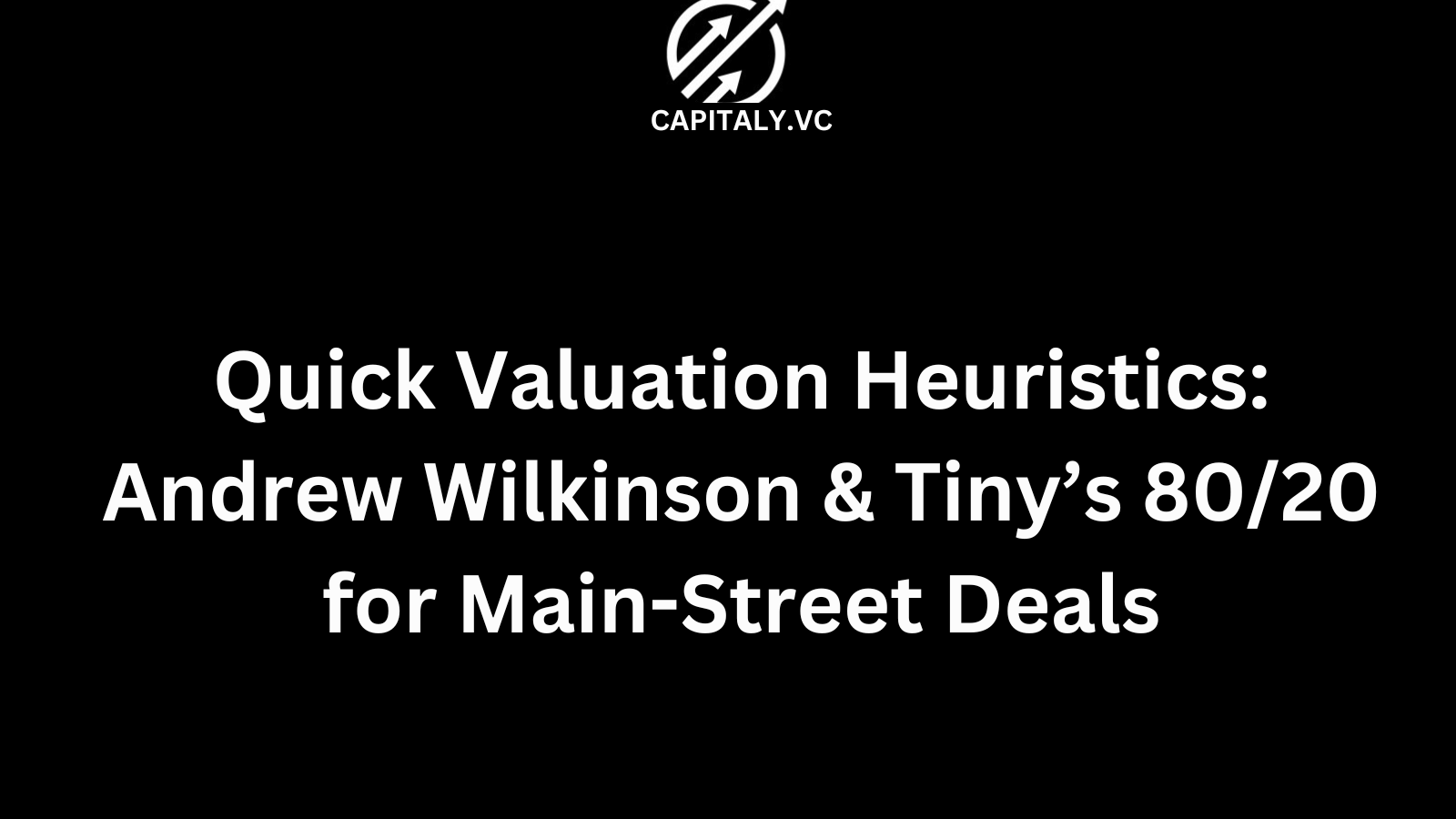Quick Valuation Heuristics: Andrew Wilkinson & Tiny’s 80/20 for Main-Street Deals
Quick Valuation Heuristics: Andrew Wilkinson & Tiny’s 80/20 for Main-Street Deals

Quick Valuation Heuristics: Andrew Wilkinson & Tiny’s 80/20 for Main-Street Deals is my plain-English cheat sheet to price small, profitable businesses fast.
I’ll show you the shortest path from messy numbers to a tight offer range you can defend.
I’ll keep every sentence on its own line.
I’ll use simple math you can run on a napkin.
I’ll add examples so you can sanity-check your price in minutes.

What I Mean By “80/20 Valuation”
I care about cash, durability, and time to payback.
I don’t get lost in 40-tab models.
I triangulate a range using three lenses: SDE/EBITDA multiple, FCF multiple, and payback period.
Then I pressure-test with risk factors and working-capital needs.
For decision hygiene, see our post: I Don’t Respond to Long Emails.
SDE vs. EBITDA: Pick the Right Base
Main-street deals often quote SDE (owner’s salary added back).
Bigger deals quote EBITDA.
If the owner is truly replaceable, swap SDE’s “owner comp” for a market GM salary.
Overstating add-backs inflates value and kills trust.
The Three-Number Triangle
I run three quick numbers.
Multiple on SDE/EBITDA, Multiple on FCF, and Simple Payback (Price ÷ FCF).
If all three rhyme, I’m close.
If they diverge, I find the lie.
The “Cash Engine” Baseline (Unlevered FCF)
Start with EBITDA.
Subtract maintenance capex.
Adjust for the working capital the business actually needs.
Land on unlevered free cash flow.
That’s the number that pays me back.
Napkin Range: Calm Service SMB (Non-SaaS)
If FCF is $1.2M, I sanity-check 3.5–5.0× FCF.
That’s $4.2M–$6.0M headline before WC and fees.
Payback target 2.5–3.5 years.
Faster payback justifies higher certainty and more cash at close.
Napkin Range: Sticky B2B SaaS (Low Churn)
If NRR ≥100% and churn is calm, I lean to 6–9× EBITDA or 5–7× FCF.
If growth is modest but durable, price the moat, not the hype.
If churn or concentration bites, slide down a turn.
For compounding taste, see: A $3,600 Keyboard and a $66 Million Dollar Investment.
Napkin Range: Agencies & Productized Services
If margins are steady and client concentration is low, I see 3–4× EBITDA.
If key person risk is high, I compress to 2–3× until SOPs and bench depth improve.
Documented delivery beats “we hustle harder.”
Napkin Range: E-commerce With Inventory
I value on FCF after true inventory needs.
High seasonality and obsolescence push me to 2.5–4× FCF.
If the brand has pricing power and repeat rates, stretch slightly.
Inventory truth beats optimism.
Payback Period: The Great Equalizer
I target ≤3 years for most main-street deals.
I’ll accept 3–4 if the moat is obvious.
Longer than 4 and I want a lower price or better terms.
Payback cuts through multiple theater.
Risk Scoring: Slide the Multiple, Don’t Argue Religion
I adjust ±0.5–1.0 turns for five risks.
Churn, concentration, key person, platform dependency, working-capital intensity.
Each big red flag lowers the range.
Each mitigated risk lets me stretch.
Owner Add-Backs: What I Accept Fast
Yes: one-time legal, true one-off migrations, dead SKUs, owner car trips to Cabo (kidding, mostly).
No: permanent contractors labeled “temporary,” under-market owner salary with no replacement plan.
If it wouldn’t fly after close, don’t add it back.
Working Capital Peg: The Quiet Price Lever
Set the peg from 12 monthly snapshots.
Define inclusions/exclusions in one paragraph.
Agree to a dollar-for-dollar true-up.
This is real money at funding.
For cadence, skim: Delete 95% of Your Email.
Simple Debt Coverage Check (If Using Bank Debt)
Compute DSCR = FCF / (Annual Debt Service).
I want ≥1.5× cushion post-close.
If DSCR is tight, I lower price or raise equity.
Cash beats bravado.
The “Rule of Price Increases”
If you raised prices in the last 12 months and NRR stayed ≥100%, I stretch the multiple.
If churn spiked, I compress.
Price power is a moat in plain sight.
The “No Single Point of Failure” Test
If one person, platform, or customer can crater EBITDA by >20%, I haircut.
If SOPs, backups, and cross-training exist, I relax the discount.
Document resilience to get paid.
Turn SDE Into EBITDA (And Back) Fast
EBITDA = SDE − market GM salary − duplicated owner perks that must continue.
SDE = EBITDA + true owner comp + owner-specific perks you won’t need.
Keep receipts.
Keep it boring.
The “Drop Ads” Stress Test
Model FCF with paid acquisition paused for 90 days.
If the base still throws off cash, durability is real.
If everything dies, the multiple dies with it.
Buy Box I Send to Brokers or Founders
I state profit range, business type, risk lines, and timeline.
I cap customer concentration at 25%, platform dependence at one major, and payback at ≤3 years.
I close in ~30 days if the data room is tight.
For short notes that get answers, read: Never Tell, Always Storytell.
Example: From Numbers to Offer In 5 Lines
EBITDA $2.0M.
Maintenance capex $200k.
WC delta $100k.
FCF $1.7M.
Offer range $6.0–$7.5M (≈ 3.5–4.4× FCF), payback 3.5–4.4 yrs → push terms or find levers to lift FCF to hit ≤3 years.
FAQs
What multiple should I use if the business is owner-heavy.
Use SDE but subtract a market replacement salary to simulate reality.
How do I value a fast-growing but lumpy business.
Anchor on FCF and payback, then stretch the top end if retention and pricing power are proven.
When should I price on revenue instead of profit.
Rarely.
Only when margins are standardized and profit is temporarily suppressed by obvious, short-term investments.
How do I compare two offers with different structures.
Convert to cash at close, apply the peg, and discount contingent pieces for risk and time.
What’s a healthy escrow.
Often 5–15% for 12 months with a cap and a small basket.
Can an earnout raise my headline price.
Yes, but it adds risk.
Keep it ≤25% and ≤18 months with one metric if you must.
What moves a multiple fastest in diligence.
Clean tie-outs to bank, proven price power, and no single point of failure.
How do I treat inventory in valuation.
Value on FCF after true inventory needs and set a clean peg to avoid surprises.
What DSCR should I target if I plan to use debt.
≥1.5× after all costs to sleep at night.
What’s the simplest sanity check before sending an LOI.
Payback ≤3 years and two of three lenses (SDE/EBITDA, FCF, Payback) agree within ~10–15%.
Conclusion
Quick Valuation Heuristics: Andrew Wilkinson & Tiny’s 80/20 for Main-Street Deals boils down to three lenses and five risk sliders.
Price on SDE/EBITDA, cross-check on FCF, and enforce a payback you can live with.
Adjust for churn, concentration, key person, platform risk, and working capital.
Keep it simple.
Move fast.
Get Your Copy of Never Enough at https://www.neverenough.com/


.png)